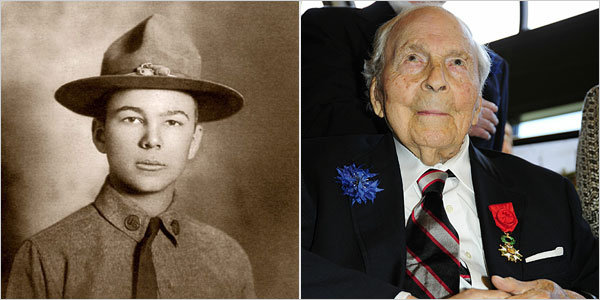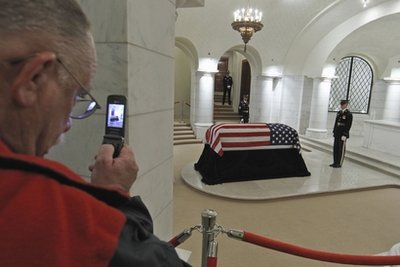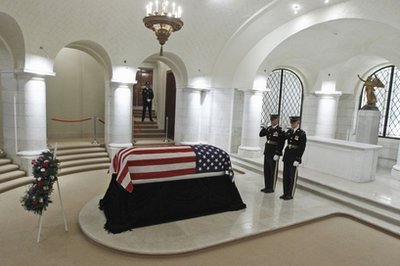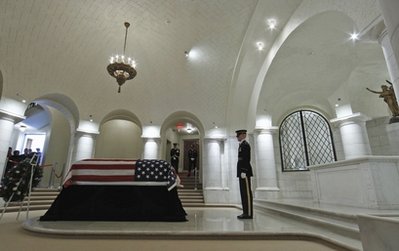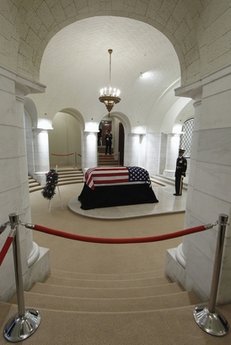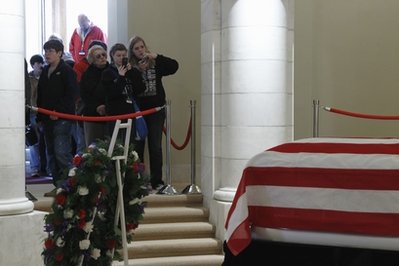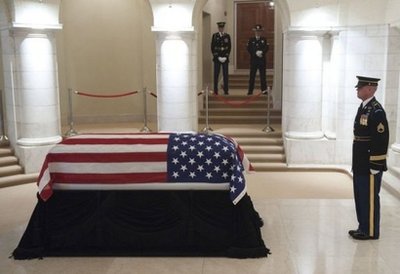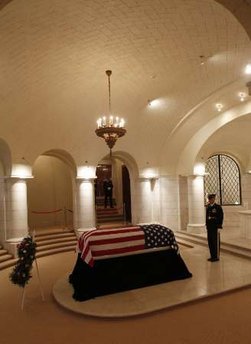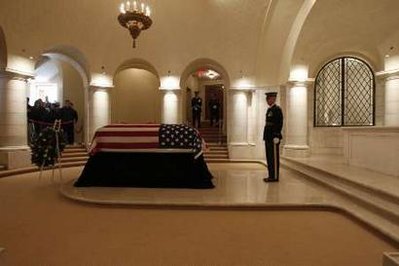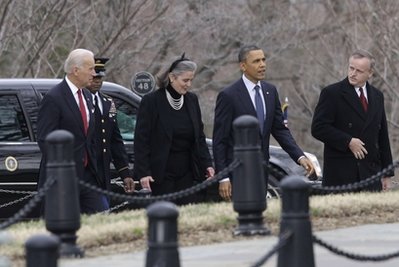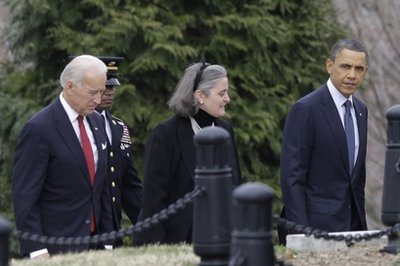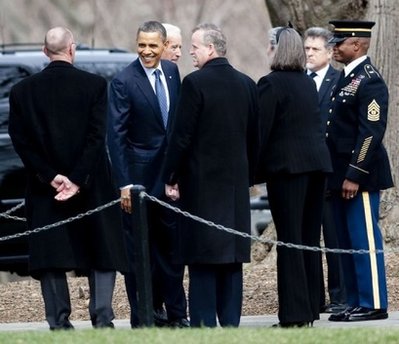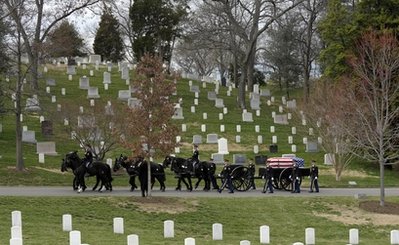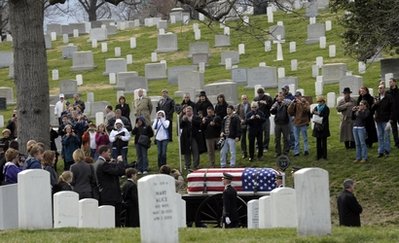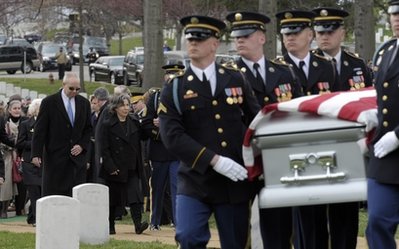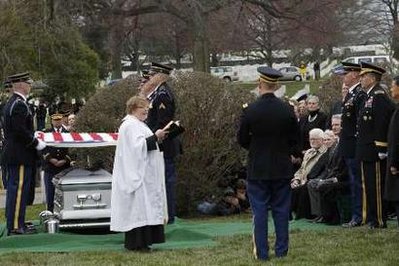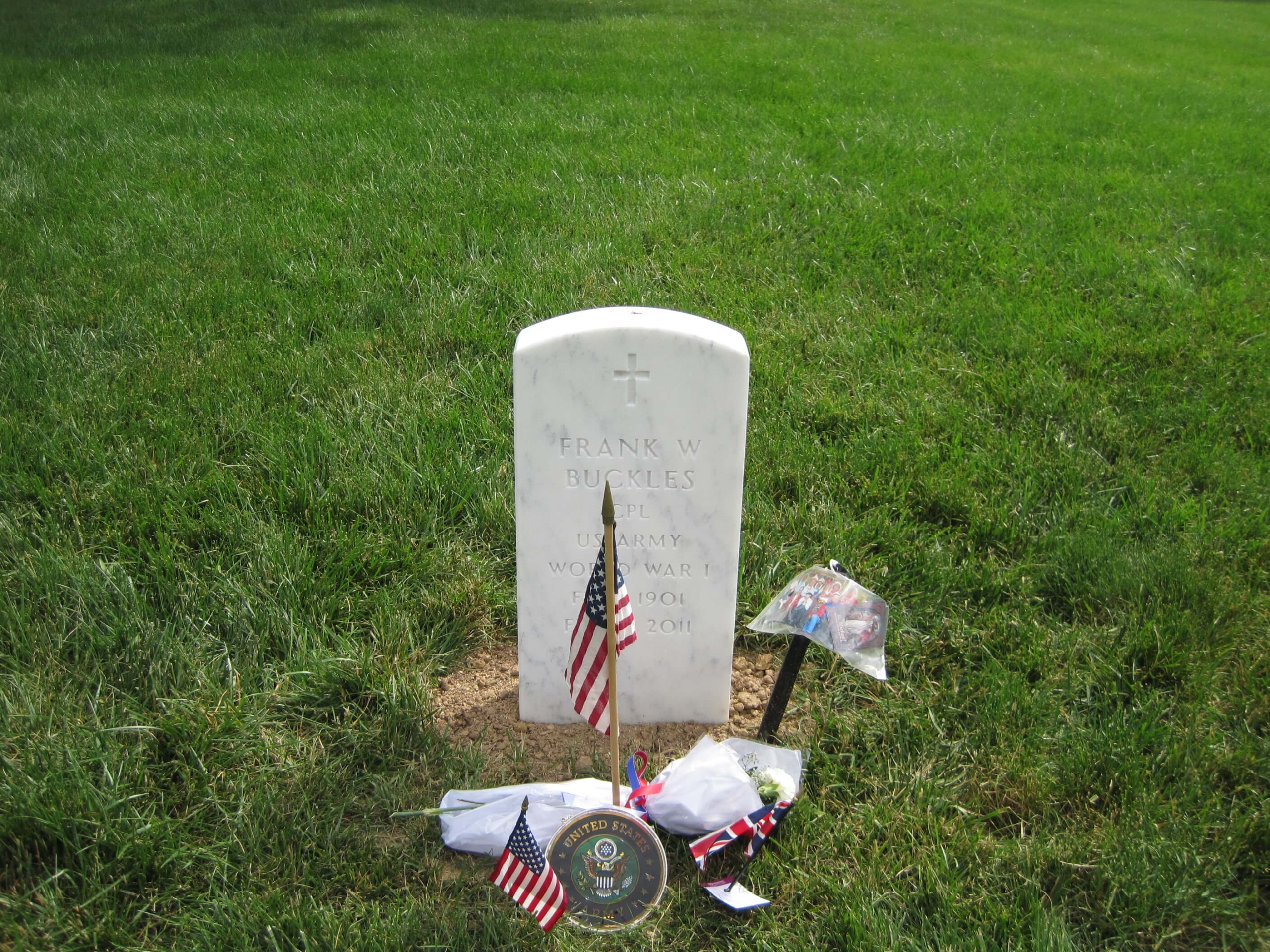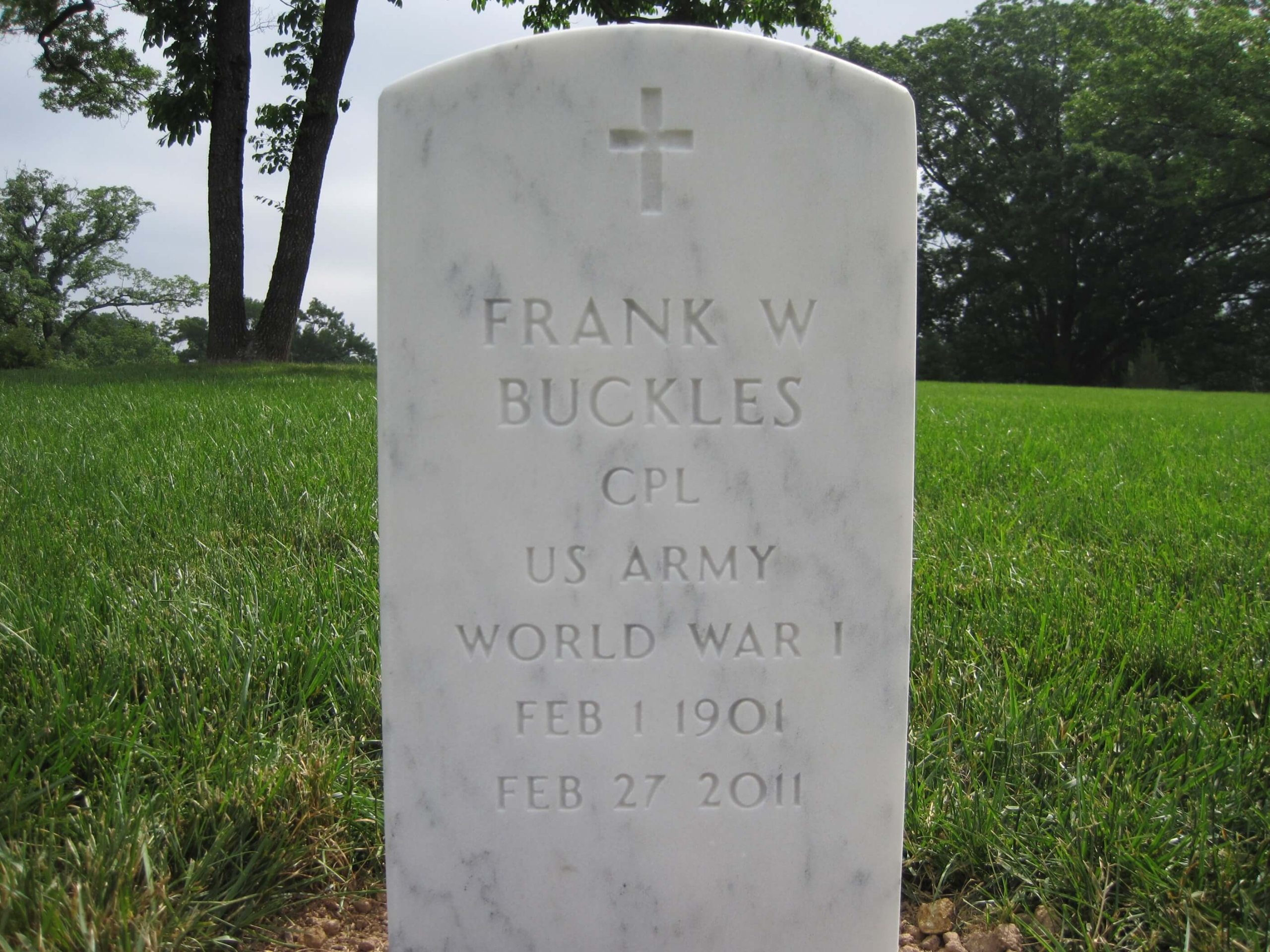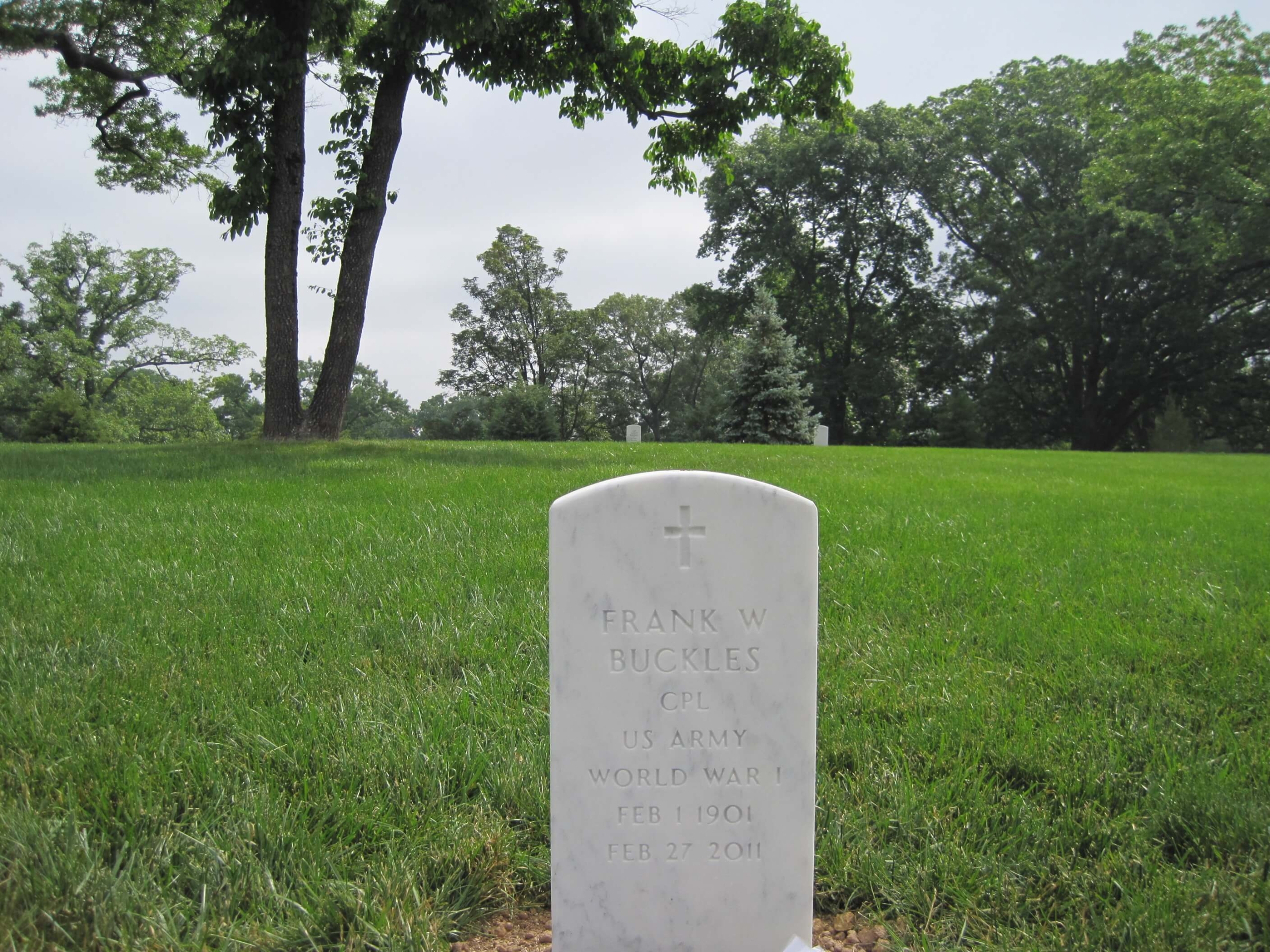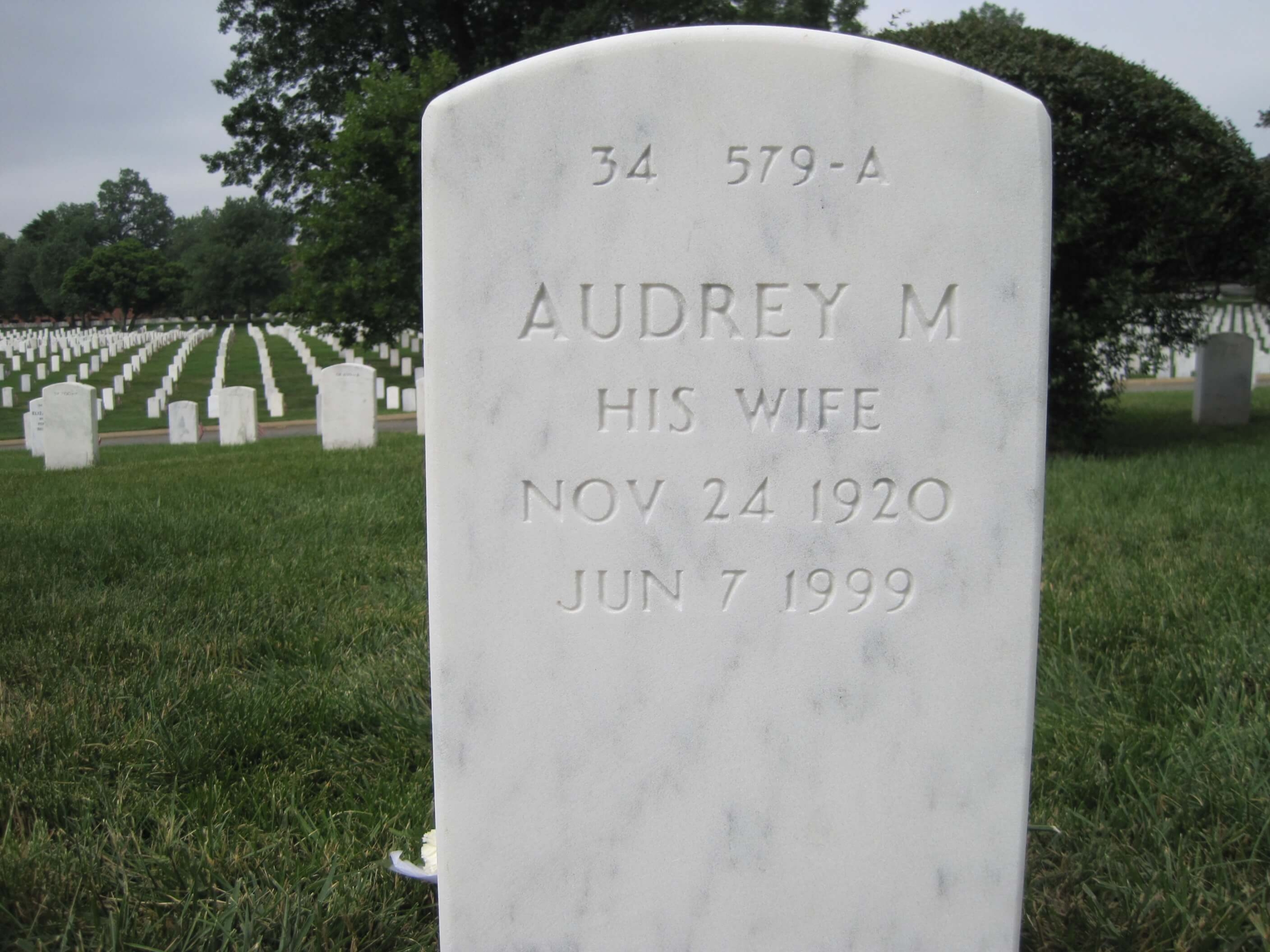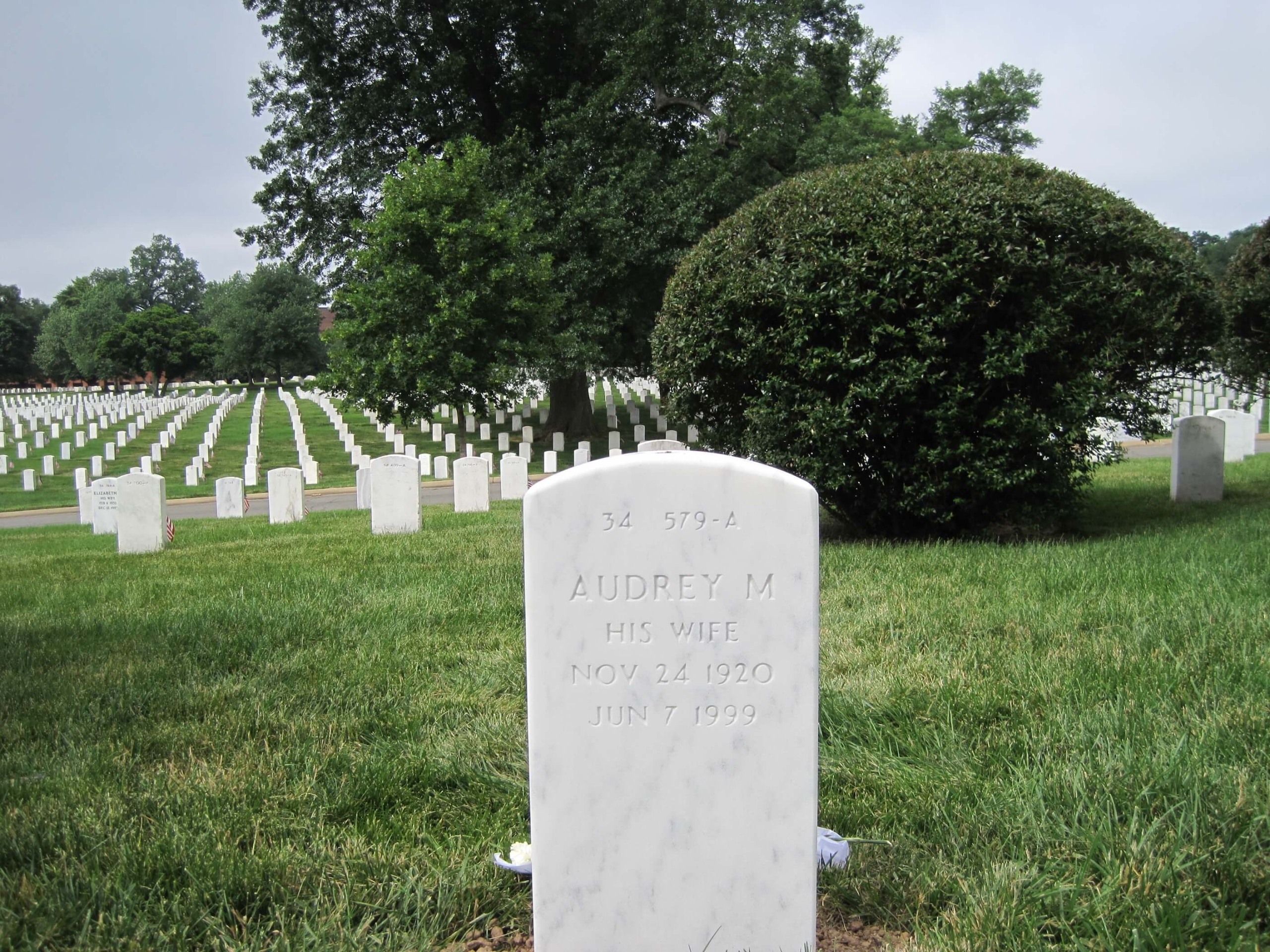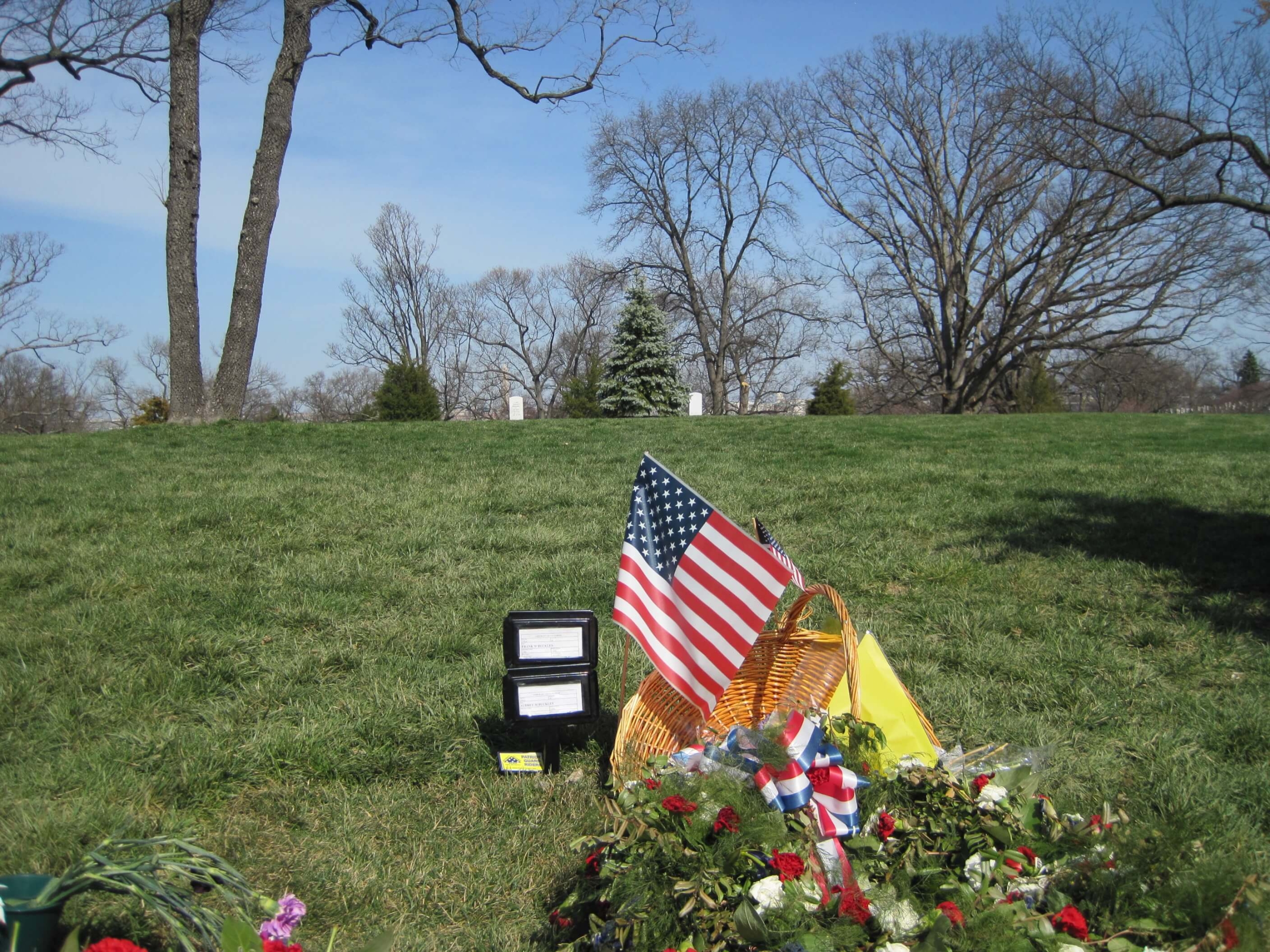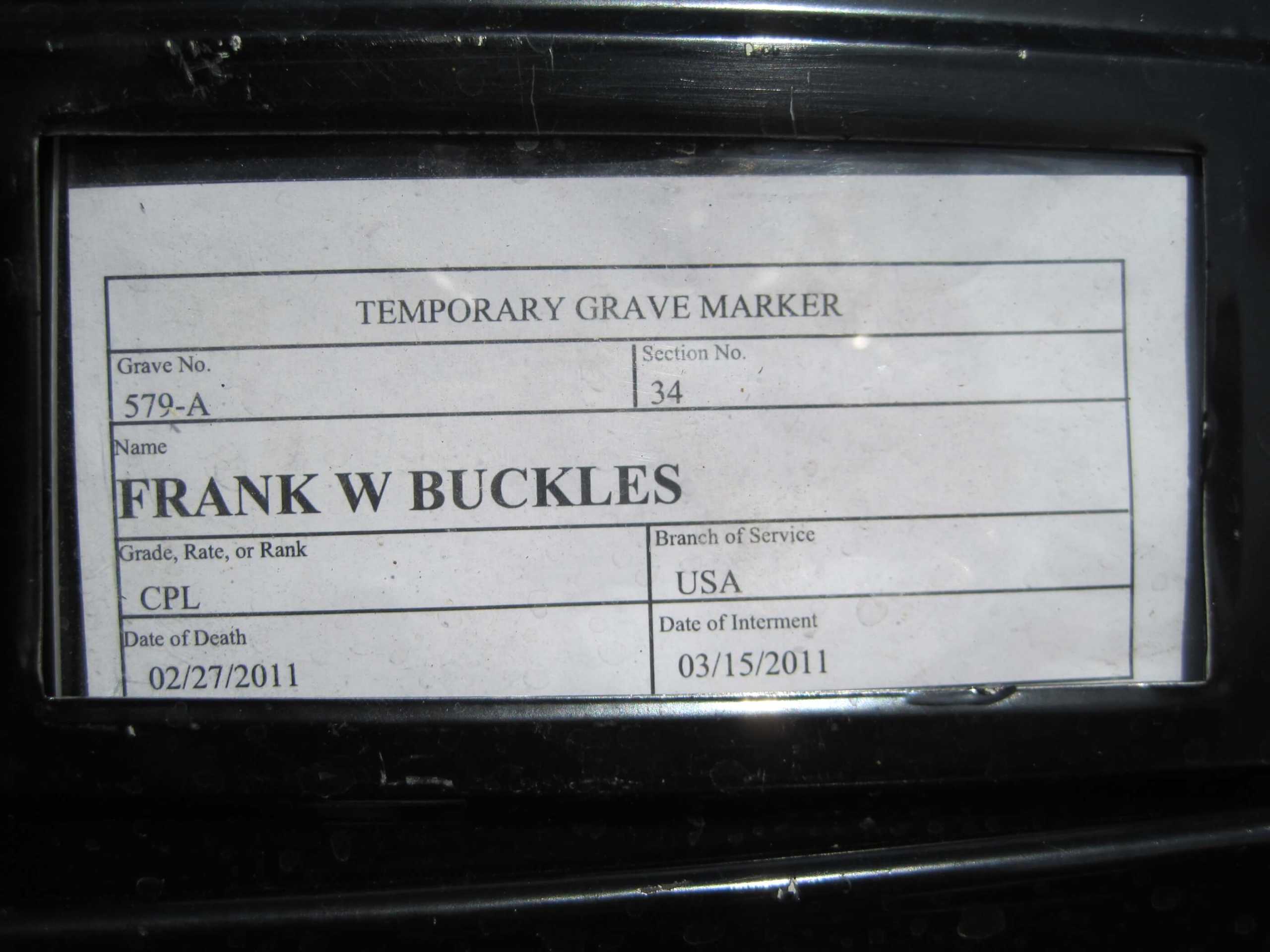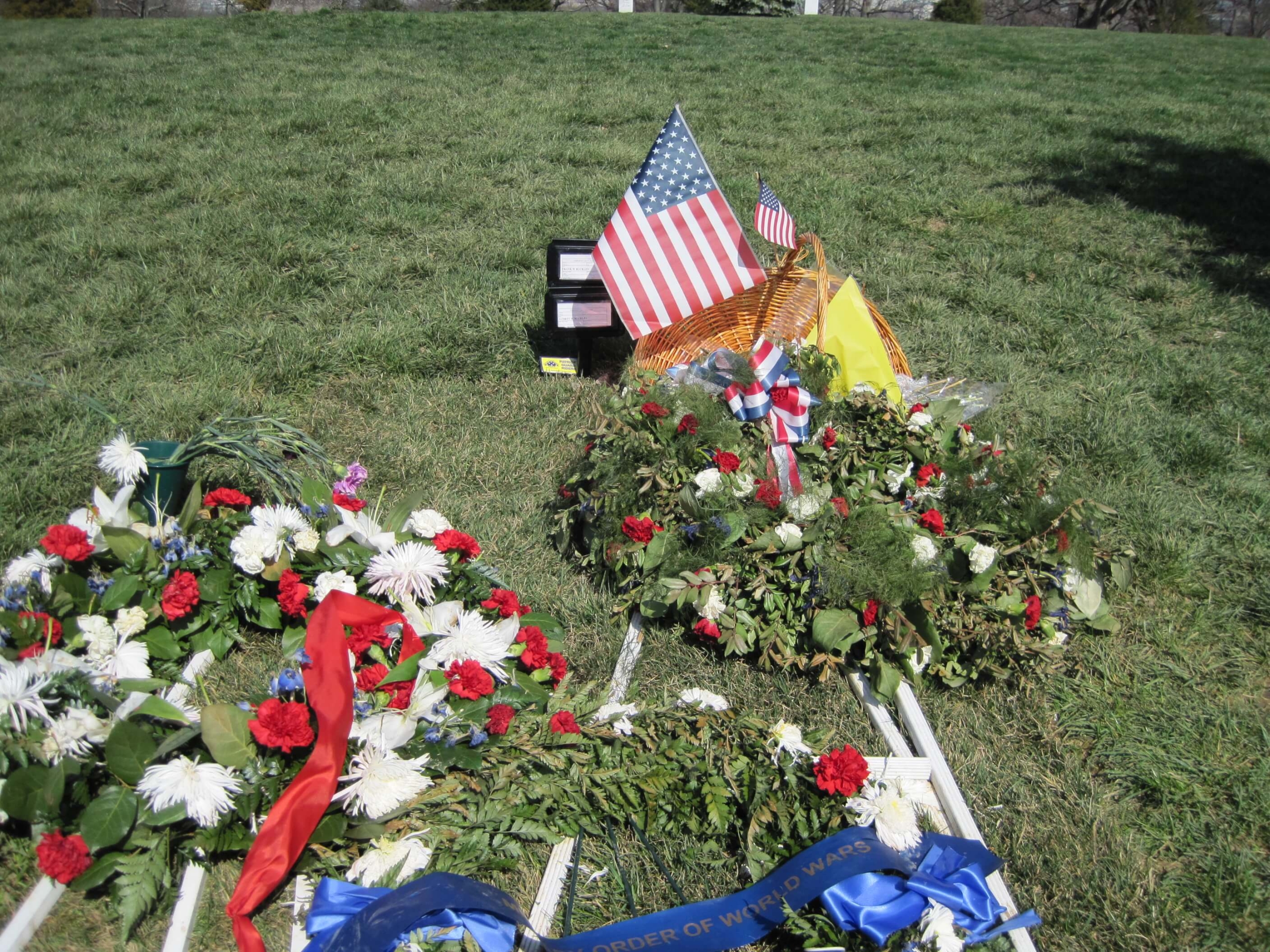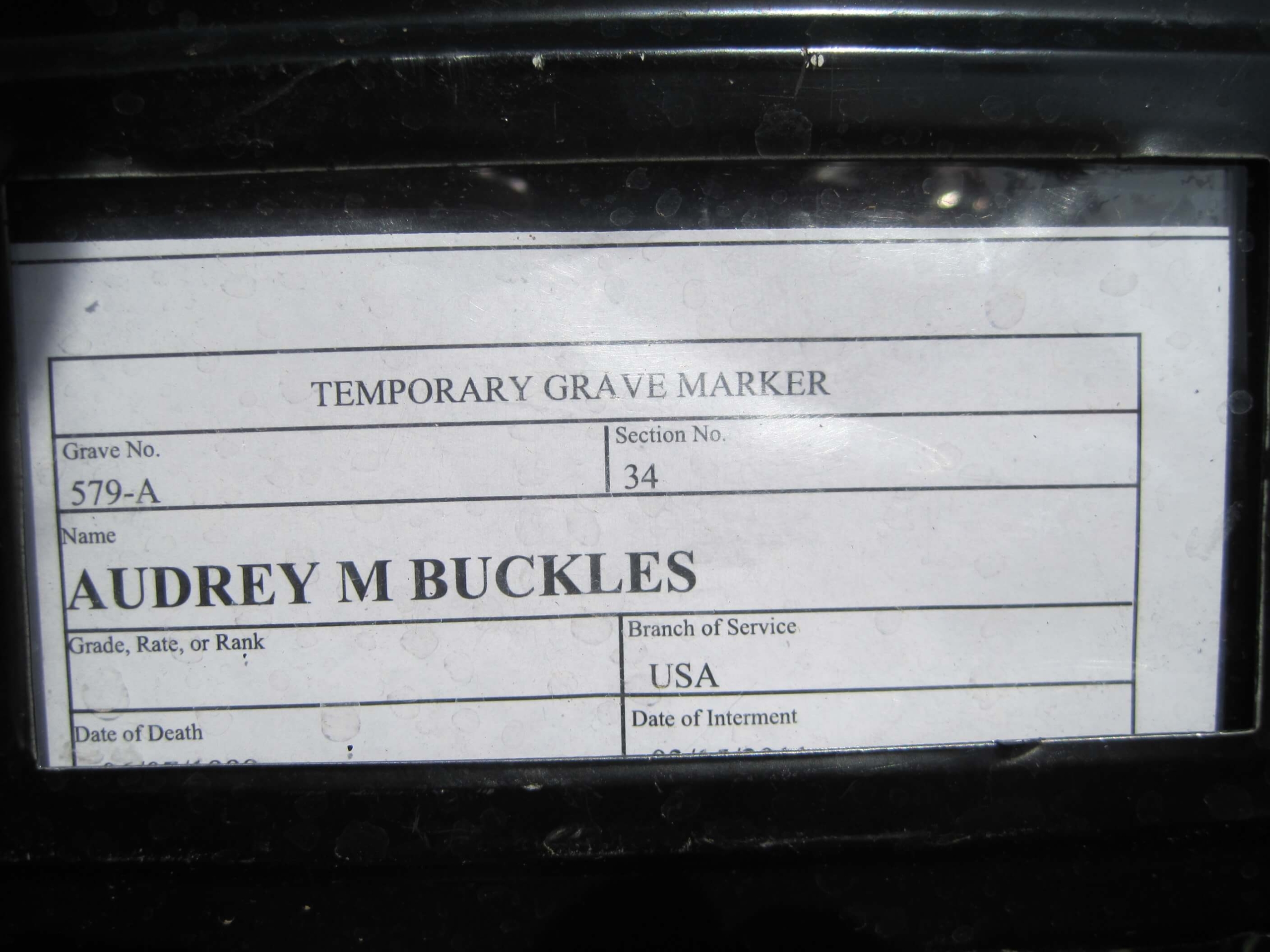28 February 2011:
Frank Buckles, who drove an Army ambulance in France in 1918 and came to symbolize a generation of embattled young Americans as the last of the World War I doughboys, died on Sunday at his home in Charles Town, West Virginia. He was 110.
His death was announced on his Web site.
He was only a corporal and he never got closer than 30 or so miles to the Western Front trenches, but Mr. Buckles became something of a national treasure as the last living link to the two million men who served in the American Expeditionary Forces in France in “the war to end all wars.”
President Obama said in a statement that Mr. Buckles lived “a remarkable life that reminds us of the true meaning of patriotism and our obligations to each other as Americans.”
Frail, stooped and hard of hearing but sharp of mind, Mr. Buckles was named grand marshal of the National Memorial Day Parade in Washington in 2007. He was a guest at Arlington National Cemetery on Veterans Day 2007 for a wreath-laying ceremony at the Tomb of the Unknowns. He was honored by Defense Secretary Robert M. Gates at the Pentagon and met with President George W. Bush at the White House in March 2008.
United States senators played host to him at the Capitol in June 2008 for the impending 90th anniversary of the World War I armistice. And he appeared before a Senate subcommittee in December 2009 to support legislation named in his honor to bestow federal status on a World War I memorial on the Washington Mall built in the 1930s.
The Department of Veterans Affairs said he would be buried at Arlington National Cemetery with full military honors.
Sought out for interviews in his final years, Mr. Buckles told of witnessing a ceremony involving British veterans of the Crimean War, fought in the 1850s, when he was stationed in England before heading to France. He remembered chatting with General John J. Pershing, the commander of American troops in World War I, at an event in Oklahoma City soon after the war’s end.
And he proudly held a sepia-toned photograph of himself in his doughboy uniform when he was interviewed by USA Today in 2007. “I was a snappy soldier,” he said. “All gung-ho.”
Frank Woodruff Buckles was born February 1, 1901, on a farm near Bethany, Missouri. He was living in Oakwood, Oklahoma, when the United States entered World War I, and he tried to enlist in the Marine Corps at age 16, having been inspired by recruiting posters.
The Marines turned him down as under-age and under the required weight. The Navy did not want him either, saying he had flat feet. But the Army took him in August 1917 after he lied about his age, and he volunteered to be an ambulance driver, hearing that was the quickest path to service in France.
He sailed for England in December 1917 on the Carpathia, the ship that helped save survivors of the Titanic’s sinking in 1912. He later served in various locations in France, including Bordeaux, and drove military autos and ambulances. He was moved by the war’s impact on the French people.
“The little French children were hungry,” Mr. Buckles recalled in a 2001 interview for the Veterans History Project of the Library of Congress. “We’d feed the children. To me, that was a pretty sad sight.”
Mr. Buckles escorted German prisoners of war back to their homeland after the Armistice, then returned to the United States and later worked in the Toronto office of the White Star shipping line.
He traveled widely over the years, working for steamship companies, and he was on business in Manila when the Japanese occupied it after the attack on Pearl Harbor in December 1941. He was imprisoned by the Japanese and lost more than 50 pounds before being liberated by an American airborne unit in February 1945.
After retiring from steamship work in the mid-1950s, Mr. Buckles ran a cattle ranch in Charles Town, and he was still riding a tractor there at age 106.
In April 2007, Mr. Buckles was identified by the Department of Veterans Affairs as one of the four known survivors among the more than 4.7 million Americans who had served in the armed forces of the Allied nations from April 6, 1917, when the United States entered World War I, to November 11, 1918, the date of the armistice.
Two of the four — J. Russell Coffey and Harry Landis — had served stateside in the American Army. Mr. Coffey died in December 2007 at 109; Mr. Landis, in February 2008 at 108. John Babcock, who was born in Canada, served in the Canadian Army in Britain in World War I and held dual American and Canadian citizenship, died in Spokane, Washington, in February 2010 at 109.
The last known veterans of the French and German armies in World War I, Lazare Ponticelli and Erich Kästner, respectively, died a few months apart in 2008; Harry Patch, the last British soldier, died in 2009. Claude Choules, who served in Britain’s Royal Navy and now lives in Australia, and Florence Green, a member of Britain’s Women’s Royal Air Force and who lives in England, are thought to be the only two people still living who served in any capacity in the war.
Mr. Buckles is survived by his daughter, Susannah Flanagan. His wife, Audrey, died in 1999.
More than eight decades after World War I ended, Mr. Buckles retained images of his French comrades. And he thought back to the fate that awaited them.
“What I have a vivid memory of is the French soldiers — being in a small village and going in to a local wine shop in the evening,” he told a Library of Congress interviewer. “They had very, very little money. But they were having wine and singing the ‘Marseillaise’ with enthusiasm. And I inquired, ‘What is the occasion?’ They were going back to the front. Can you imagine that?”
Frank Woodruff Buckles (born Wood Buckles: February 1, 1901 – February 27, 2011) was one of the last three surviving World War I veterans, and of those three he was the only American. Buckles enlisted in the United States Army in August 1917 and went through basic training at Fort Riley in Kansas. Serving from the Army's 1st Fort Riley Casual Detachment, he drove ambulances and motorcycles near the frontlines, though he never saw combat. Honorably discharged in 1919, Buckles continued to serve with the Seventh Regiment of the New York National Guard from 1922 to 1923. During World War II, Buckles was not in the military but he spent the majority of the conflict as a prisoner of war after being captured by the Japanese while working in the shipping business. After the world wars, Buckles married in San Francisco in 1946 and moved to Gap View Farm in Charles Town, West Virginia. His wife, Audrey, gave birth to their daughter in 1955. A widower at age 98, he worked on his farm until age 105.
In his last years, he was the Honorary Chairman of the World War I Memorial Foundation, campaigning to have the District of Columbia War Memorial renamed the National World War I Memorial, including meeting with President George W. Bush. Buckles was also a Shriner, a Freemason, a member of the Sons of Confederate Veterans, the Sons of the American Revolution and a church-going man. He was awarded the World War I Victory Medal and the Army of Occupation of Germany Medal at the conclusion of the First World War, as well as the French Legion of Honor in his last years. At the time of his death, Buckles was the oldest verified World War I veteran in the world, the second-oldest male military veteran in the world and the last field veteran of the war. He was buried on March 15, 2011 at Arlington National Cemetery with full military honors.
Buckles was born on February 1, 1901 to James C. and Theresa J. Buckles, in Bethany, Missouri.[6] Buckles had two sisters, Grace and Gladys and one brother, Ashman. Ashman, died of scarlet fever in 1903, at the age of 4; Buckles also contracted the disease but survived. Between 1911 and 1916, Buckles attended school in Nevada, Missouri. He and his family subsequently moved to Dewey County, Oklahoma. Buckles' ancestors had first settled in 1732 around the area that would become his home later in life, Charles Town, West Virginia (at the time part of Virginia), and Buckles was descended from a Revolutionary War soldier. Another ancestor was a Civil War veteran.
After the American entry into World War I, Buckles sought to enlist in the armed forces. He was turned down by the Marine Corps because of his slight weight and for being under 21, and by the Navy, who incorrectly diagnosed him with flat feet. He was successful in enlisting in the United States Army in August 1917, at the age of 16 years.
Buckles enlisted on August 14, 1917 and went through basic training at Fort Riley in Kansas. Later that year, he embarked for Europe aboard the RMS Carpathia, which was being used as a troop ship. Five years previously, she had rescued RMS Titanic survivors. While on Carpathia, Buckles spoke with crew members who had taken part in the rescue of Titanic survivors. During the war Buckles served in England and France, driving ambulances and motorcycles for the Army's 1st Fort Riley Casual Detachment. Buckles later recalled his service as a doughboy:
“There was never a shortage of blown-up bodies that needed to be rushed to the nearest medical care. The British and French troops were in bad shape – even guys about my age looked old and tired. After three years of living and dying inside a dirt trench, you know the Brits and French were happy to see us “doughboys.” Every last one of us Yanks believed we’d wrap this thing up in a month or two and head back home before harvest. In other words, we were the typical, cocky Americans no one wants around, until they need help winning a war.”
A belt buckle similar to the one given to Buckles by a German prisoner in 1918. The inscription reads “Gott mit uns”, meaning “God with us”.
After the Armistice in 1918, Buckles escorted prisoners of war back to Germany. One German prisoner gave him a belt buckle inscribed, “Gott mit uns” (meaning God with us), which he kept as a souvenir for the rest of his life.
Buckles was promoted to Corporal on September 22, 1919. Following his honorable discharge in November 1919, he attended the dedication of the Liberty Memorial in Kansas City, Missouri, in honor of the Americans who died in World War I, and met General John Pershing, the commander of all United States forces in France during the war. Buckles served in the Seventh Regiment of the New York National Guard from 1922 to 1923 while he lived in New York City. Buckles attended business school in Oklahoma City and then worked as Chief Purser for steamship lines in South America, Europe, and Asia.[18] In the 1930s, he received an Army bonus of $800 (equal to about $12,000 in 2011 dollars), which he gave to his father who was struggling as a farmer in the Oklahoma Dust Bowl.
By 1942, Buckles had worked for the White Star, American President, and W.R. Grace shipping companies, and shipping business took him to Manila in the Philippines. He was captured there by the Japanese in 1942 and spent the next three and a half years in the Los Baños prison camp. He became malnourished due to a diet of a small mush-like meal served in a tin cup, a utensil he still had at the time of his death. With a weight below 100 pounds, Buckles developed beriberi, yet led his fellow prisoners in calisthenics. He was freed by Allied forces on February 23, 1945. During his captivity, Buckles learned some Japanese. He was fluent in German, Spanish, and French.
After World War II, he moved to San Francisco, where he married Audrey Mayo in 1946. In January 1954, retired from steamship work, he bought the 330-acre Gap View Farm in West Virginia where he raised cattle. Audrey gave birth to their only child, a daughter named Savannah, in 1955.
In 1973, nearly all of Frank Buckles' military service record was destroyed in the National Personnel Records Center fire. Some of the record was salvaged, consisting mostly of burned pay records, and since has been classified as a high profile record by the Military Personnel Records Center. His wife died in 1999 and their daughter moved back to the farm to care for him.
Buckles at age 107 meeting with President George W. Bush in the Oval Office After the turn of the century, Buckles continued living near Charles Town, West Virginia and was still driving a tractor on his farm at age 103. He stated in an interview with The Washington Post on Veterans' Day 2007 that he believed the United States should not go to war “unless it's an emergency”. When asked about the secret of his long life, Buckles replied: “Hope,” adding, “When you start to die… don't.” He also said the reason he had lived so long was that he “never got in a hurry.” In another interview at age 110, Buckles explained the secret of long life as “Genetics, healthy eating and exercise are vital for a long life,” but “the will to survive is what's most important.”
Buckles' life was featured on the Memorial Day 2007 episode of NBC Nightly News. On February 4, 2008, with the death of 108-year-old Harry Richard Landis, Buckles became the last surviving American World War I veteran.[33] Buckles was named ABC's World News Tonight's “Person of the Week” for his fight to have the District of Columbia War Memorial turned into the “National World War I Memorial”, on March 22, 2009.
On March 6, 2008, he met with United States President George W. Bush at the White House.[35][36] The same day, he attended the opening of a Pentagon exhibit featuring photos of nine centenarian World War I veterans created by historian and photographer (and later family spokesman) David DeJonge. The following summer he visited wounded soldiers at Walter Reed Army Medical Center.
Buckles was the Honorary Chairman of the World War I Memorial Foundation, which seeks refurbishment of the District of Columbia War Memorial and its establishment as the National World War I Memorial on the National Mall. Buckles appeared before Congress on December 3, 2009, advocating on behalf of such legislation. Also in December 2009, a lifelong Shriner, Buckles was given a plaque for being a “famous Shriner”. Buckles was part of the Osiris Shriners of Wheeling, West Virginia, and also a Freemason. At the time of his death, Buckles was “the oldest Shriner in Shrinedom.” Buckles also had an interest in genealogy; he had been a member of the West Virginia Society Sons of the American Revolution since 1935, and was active for many years in the Sons of Confederate Veterans.
On February 1, 2010—Buckles' 109th birthday—his official biographer announced that he was completing a documentary, entitled “Pershing's Last Patriot”, on Buckles' life. The film is a cumulative work of three years of interviews and intimate moments gathered by DeJonge, DeJonge estimates a 2011 release for the documentary.
Months away from his 110th birthday, in autumn 2010, Buckles was still giving media interviews. Buckles reached supercentenarian status upon his 110th birthday, on February 1, 2011. On February 27, 2011, Buckles died of natural causes at his home. Buckles was among the last three surviving World War I veterans in the world and was the last living American veteran of that war.
For his service during World War I, Buckles received, from the United States government, the World War I Victory Medal and qualified for four Overseas Service Bars. In 1941, he received the Army of Occupation of Germany Medal for his post war service in Europe during the year 1919. During the 1980s, Buckles may have applied for the Prisoner of War Medal for his World War II incarceration, but at the time of his imprisonment by the Japanese, Buckles was a civilian and thus did not qualify under the criteria for the medal. In 1999, Buckles was further honored by French president Jacques Chirac when Buckles was awarded France's Legion of Honour.
In 2007, the United States Library of Congress included Buckles in its Veterans History Project, which includes audio, video, and pictorial information on Buckles' experiences in both world wars, including a 148-minute video interview. In April 2008, a section of West Virginia Route 9, which passes by his Gap View Farm home, was named and dedicated in his honor by then-West Virginia Governor Joe Manchin.[9] That following month, on May 25, 2008, Buckles received the Veterans of Foreign Wars’ Gold Medal of Merit at the Liberty Memorial. He sat for a portrait taken by David DeJonge that will hang in the National World War I Museum, as “the last surviving link.” The portrait was unveiled at The Pentagon in 2008, with Defense Secretary Robert Gates in attendance.
Buckles received the Scottish Rite of Freemasonry's Knight Commander of the Court of Honour (KCCH) on September 24, 2008. The KCCH is the last honor bestowed by the Southern Jurisdiction prior to the 33° or thirty-third degree, the highest honor in Freemasonry. The ceremony was hosted by Ronald Seale, 33°, the Grand Commander of the Scottish Rite of Freemasonry for the Southern Jurisdiction.
Frank Woodruff Buckles’ life spanned the awesome, horrible, fantastic, dreadful Twentieth Century. He saw and experienced much. As America’s last surviving veteran witness to the First World War, his life experiences and perspective are an artifact in our day which often lacks perspective…. It is not so much about Frank, but all he represents.
Prior to Buckles' death, Businessman Ross Perot, whom Frank Buckles had met at a history seminar in 2001, intervened in 2008 with the White House regarding a final resting place for Buckles. Buckles did not meet the criteria for burial at Arlington National Cemetery as he had never been in combat, but special permission was secured on March 19, 2008. On February 28, 2011, President Barack Obama issued a presidential order that the American flag be flown at half-staff on all government buildings, embassies, and at the White House on March 15 when Buckles was buried.[59] In the days leading up to Buckles' funeral, the governors of 16 states followed suit in calling for the lowering of their states' flags to half-staff on March 15.
The United States Senate passed a resolution honoring Buckles as “the last veteran to represent the extraordinary legacy of the World War I veterans” on March 3, 2011. A number of statements were made by representatives and senators paying tribute to Buckles and the World War I veterans and concurrent resolutions were proposed in both the Senate and the House of Representatives to allow Buckles to lie in honor in the United States Capitol rotunda. The resolution, however, was reported as being blocked by the Speaker of the House John Boehner and Senate Majority Leader Harry Reid, who sought permission instead for a ceremony to be held in the Amphitheater of Arlington National Cemetery. It was reported that the request for Buckles to lie in honor was supported by his daughter. On March 10, Sir Winston Churchill's great-grandson, Jonathan Sandys, urged Congress to allow Buckles to lay in repose in the Rotunda.
Northeast Vernon County High School in Nevada, Missouri, Buckles' former high school, held a service honoring his “life and service”, on March 8, 2011.Also on March 8, 2011, Buckles' home church, Zion Episcopal Church in Charles Town, West Virginia, announced it would hold a memorial service for Buckles. The latter service was held on March 16, 2011 and was officiated by the Episcopal bishop of West Virginia, as well as the local pastor.[26] Memories were shared by Buckles' son-in-law, his nephew, among others.
On March 10, 2011, family spokesperson David DeJonge announced that Buckles would be buried at Arlington National Cemetery in a private ceremony.[Whether Buckles would lay in repose in the United States Capitol Rotunda, however, remained tied up in Congress. On March 11, 2011, the United States Department of Defense confirmed that Buckles would lie in honor at Arlington National Cemetery and announced details for the day of the interment on March 15. On March 12, 2011, a ceremony was held at the Liberty Memorial in Kansas City, Missouri, to honor Buckles and the “passing of the generation that fought World War I”. The keynote speaker was retired United States Air Force general and former Chairman of the Joint Chiefs of Staff Richard Myers.[85] The ceremony included a reading of poems, one of which was In Flanders Fields. On March 13 and 14, 2011, a visitation was held at a Northwest Washington, D.C. funeral home. A special ceremony at Arlington National Cemetery's Memorial Amphitheater Chapel and interment was held on March 15, where Buckles was buried with full military honors in plot 34, near Buckles former commander, General John J. Pershing. During the ceremony prior to burial, President Barack Obama and Vice President Joe Biden paid their respects and met with Buckles' family. Buckles' flag-draped coffin was borne to the burial plot on a caisson drawn by seven horses, and the folded flag was handed to his daughter by United States Army Vice Chief of Staff General Peter W. Chiarelli. Part of the honor guard for Buckles' funeral were five members of the Blackfeet Warrior Society of Browning, Montana.
In Martinsburg, West Virginia, on March 26, 2011, a candlelight vigil will be held in memory of Buckles. Donations will be taken at the time of the vigil to pay for a planned statue of Buckles holding the reins of General Pershing's horse. The statue will be placed in Buckles' hometown of Charles Town, West Virginia when finished.
Services For Corporal Frank Woodruff Buckles In The Chapel of the Memorial Amphitheater, Arlington National Cemetery:
President Barack Obama and Vice President Joe Biden walks with Kathryn A. Condon. Executive Director. Army National Cemeteries Program, and Arlington National Cemetery Superintendent Patrick Hallinan as they arrive for the funeral service for Army Corporal Frank Buckles
President Barack Obama (2nd L) and Vice President Joe Biden (3rd L) depart Arlington National Cemetery after meeting with the family of Frank Buckles, the last American veteran of World War I who is being laid to rest with full military honors, in Arlington
A caisson carries the casket of Army Corporal Frank Buckles, the last American veteran of World War I, to the graveside service at Arlington National Cemetery Tuesday, March 15, 2011.
Family and friends attend the burial service for Army Corporal Frank Buckles, the last American veteran of World War I at Arlington National Cemetery Tuesday, March 15, 2011
Susannah Flanagan, daughter of Army Corporal Frank Buckles, the last American veteran of World War I, is escorted to the graveside funeral service for her father at Arlington National Cemetery Tuesday, March 15, 2011
Reverend Melanie McCarley of the Rector Zion Episcopal Church of Charles Town, West Virginia presides over the burial service for the late Army Corporal Frank Buckles at Arlington National Cemetery Virginia March 15, 2011.
BUCKLES, FRANK W
CPL US ARMY
WORLD WAR I
- DATE OF BIRTH: 02/01/1901
- DATE OF DEATH: 02/27/2011
- BURIED AT: SECTION 34 SITE 579-A
ARLINGTON NATIONAL CEMETERY
BUCKLES, AUDREY M
- DATE OF BIRTH: 11/24/1920
- DATE OF DEATH: 06/07/1999
- BURIED AT: SECTION 34 SITE 579-A
ARLINGTON NATIONAL CEMETERY - WIFE OF BUCKLES, FRANK W
CPL US ARMY
Michael Robert Patterson was born in Arlington and is the son of a former officer of the US Army. So it was no wonder that sooner or later his interests drew him to American history and especially to American military history. Many of his articles can be found on renowned portals like the New York Times, Washingtonpost or Wikipedia.
Reviewed by: Michael Howard

